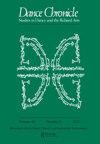One Perspective, Many Voices
IF 0.1
3区 艺术学
0 DANCE
引用次数: 0
Abstract
London Contemporary Dance School (LCDS) opened in 1966 in modest premises in Berners Place, close to Oxford Street in central London, moving to The Place (near Euston Station), the location with which it is most associated, in 1969. Both authors of Changing the Face of British Dance: Fifty Years of London Contemporary Dance School worked at the school in its early days: Richard Bannerman, for a short time as Promotion Secretary, and Henrietta Bannerman, who had studied at the Graham School in New York in the early 1960s, for several years as school secretary, choreographer, and teacher of technique. After an absence of some years and following postgraduate studies, Henrietta returned in 2005 as head of research and has published widely on the work of Martha Graham. Both authors, then, are in a position to write with some authority on the first fifty years of the school, mapping the school’s growth from a small, privately funded venture to one of the UK’s leading professional training schools for contemporary dance. The book takes a chronological approach, beginning with the genesis of the school in the 1950s and early 1960s, with some of the twelve chapters devoted to significant events in a single year and some to events over five years or more; clearly some years were more momentous than others. There are fifty black-and-white photographs, some of which are portraits of notable individuals connected with the school (such as Robin Howard, the founder of the school) and some of dancers dancing (mostly former students who have had illustrious careers as dancers and choreographers, such as Siobhan Davies); these are beautifully produced. However, the authors could have scanned and enlarged the photographs of significant documents (such as the announcement in the Dancing Times of the establishment of the school) for easier reading. As the authors state, the uniqueness of LCDS “lies in its integration with all the activities of The Place” (p. 2), for the school sits within an一个观点,多种声音
伦敦当代舞蹈学校(LCDS)于1966年在靠近伦敦市中心牛津街的伯纳斯广场(Berners Place)的一处简陋的校舍内开办,1969年迁至与之联系最密切的地方The Place(靠近尤斯顿车站)。《改变英国舞蹈的面貌:伦敦当代舞蹈学校五十年》一书的两位作者早期都曾在该校工作:理查德·班纳曼曾短暂担任推广秘书,亨丽埃塔·班纳曼于20世纪60年代初在纽约格雷厄姆学校学习了几年,担任学校秘书、编舞和技术教师。在离开几年并攻读研究生之后,Henrietta于2005年返回,担任研究主管,并广泛发表了关于Martha Graham工作的文章。因此,两位作者都有能力以一定的权威撰写关于该校成立前五十年的文章,描绘该校从一家私人资助的小型企业发展成为英国领先的当代舞蹈专业培训学校之一的历程。这本书采用了按时间顺序排列的方法,从20世纪50年代和60年代初学校的起源开始,十二章中的一些章节专门讲述了一年内的重大事件,一些章节则讲述了五年或五年以上的事件;显然,有些年份比其他年份更重要。有50张黑白照片,其中一些是与学校有关的知名人士的肖像(如学校创始人罗宾·霍华德)和一些跳舞的舞者的肖像(大多是前学生,他们在舞蹈和编舞方面有着杰出的职业生涯,如Siobhan Davies);这些产品制作精美。然而,作者本可以扫描并放大重要文件的照片(例如《舞蹈时报》上关于学校成立的公告),以便于阅读。正如作者所说,LCDS的独特性“在于它与the Place的所有活动相结合”(第2页),因为学校位于
本文章由计算机程序翻译,如有差异,请以英文原文为准。
求助全文
约1分钟内获得全文
求助全文
来源期刊

DANCE CHRONICLE
DANCE-
CiteScore
0.40
自引率
0.00%
发文量
22
期刊介绍:
For dance scholars, professors, practitioners, and aficionados, Dance Chronicle is indispensable for keeping up with the rapidly changing field of dance studies. Dance Chronicle publishes research on a wide variety of Western and non-Western forms, including classical, avant-garde, and popular genres, often in connection with the related arts: music, literature, visual arts, theatre, and film. Our purview encompasses research rooted in humanities-based paradigms: historical, theoretical, aesthetic, ethnographic, and multi-modal inquiries into dance as art and/or cultural practice. Offering the best from both established and emerging dance scholars, Dance Chronicle is an ideal resource for those who love dance, past and present. Recently, Dance Chronicle has featured special issues on visual arts and dance, literature and dance, music and dance, dance criticism, preserving dance as a living legacy, dancing identity in diaspora, choreographers at the cutting edge, Martha Graham, women choreographers in ballet, and ballet in a global world.
 求助内容:
求助内容: 应助结果提醒方式:
应助结果提醒方式:


